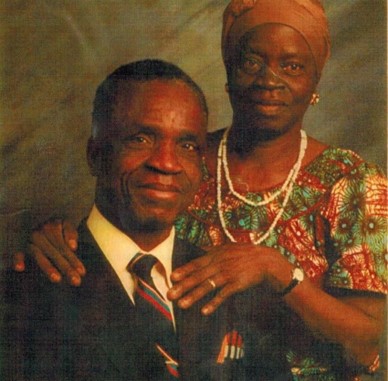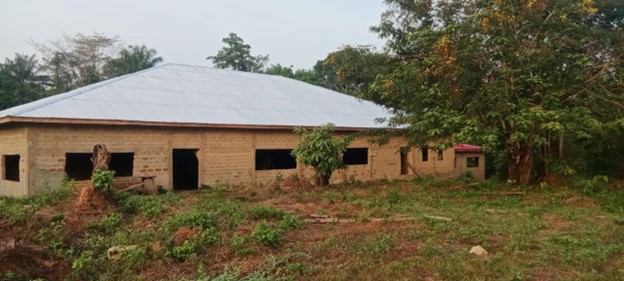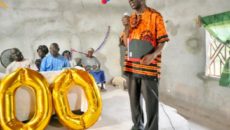This is a sponsored story, paid for by the Free Liberia Movement (https://FreeLiberia.org)
TAPPITA, Nimba – Scores of Liberians residing in Tappita, Monrovia, and the U.S. gathered in Tappita in July to celebrate the 100th birth anniversary of Rev. Mahn C Krua, the founder of the Ziah Mission School.
The institution was the first entity providing education to Liberian citizens residing in the rural part of Tappita District and beyond from the 1960s till now.
Liberia’s newest centenarian was born in Gbaseh Town, Grand Bassa on May 7, 1924 where his parents, who were traditional healers, had gone to provide medical services in the county.
His 100th birth anniversary was celebrated on July 13, after the May 7 commemoration to enable additional friends and family to travel from the U.S. to honor Krua for his contributions to the country and its people. Cllr. Taiwan Saye Gongloe was among the guests who traveled from Monrovia.
Krua accepted Jesus Christ at a young age when he was taken as an apprentice evangelist by a preacher, Garduah Gbaryou, in what is today known as Graie Township. Although he was born into a family of traditional healers, Gbaryou taught him about the gospel, and he accepted Christ at a young age.
While in Graie, the young evangelist embarked on constructing the first church in the town as a way of helping to spread the gospel since there was no church in the community. To this day, the church still stands in Graie.
Impressed by the initiative of the young Krua, missionaries from the Mid-Baptist Mission in Tappita relocated him to their mission for formal training in biblical studies at the Bible Institute established by the American missionaries at the time.
On the mission, Krua was faced with the worst form of racial discrimination by the missionaries. He was taught to read and write English so that he could read and interpret the Bible, but they did not give him formal education, as the focus of the training was only to make him understand the gospel. Despite this, Krua’s thirst for knowledge and determination to educate his community remained unshaken.
However, Krua’s desire for formal education was met with resistance. He and other indigenous students at the bible school, including Evangelists John Demey, Moses Dorliae, Jackson Gaye, Freeman Saywah, and Johnson Towah, proposed to the missionaries to establish a school for formal education. Their proposal was rejected, with the missionaries dismissing their request and emphasizing the importance of faith over education. This rejection only fueled Krua’s determination to provide education to his community. Rev. Krua formed the Ziah Mission Leadership Team, which included Peter and Martha Makor, who headed the girls’ dormitory.
These men were discriminated against, and they and their children were also denied formal education by the white missionaries.
Despite the racist attitude of the white missionaries and their refusal to establish schools for Africans on the mission to receive formal education, Krua and his colleagues kept their dream. Their primary challenge was securing funding to make their dream work.
The Liberian government at the time, which could have looked at their proposal and helped establish the school, showed no interest after being approached by the men.
Soon, their dream received a boost when they attended an annual Baptist conference at the Zondo Mission in Grand Bassa in 1954. At the meeting, they shared their dream with the visiting American preacher who had just returned from Korea and explained how the missionaries and Liberian Government had rejected their proposal of establishing a school for their children.
The preacher shared the story of how Korean Christians were experiencing a similar situation and how the Koreans defied the odds and established schools for their children against the wishes of the white missionaries there.
He inspired the men by telling them that even if the missionaries and the government were disinterested in their proposal, they should take up the challenge as the Koreans did and do it themselves. “With God, all things are possible,” he said.
The visiting preacher’s story motivated Reverend Krua and his colleagues, and upon their return to Tappita, they convened a meeting to begin planning and constructing the proposed institution.
They selected Ziah for the school site, about 17km from Tappita and the mission where the American missionaries were residing. Part of the reason for the selection of Ziah was that the community had objected to Christianity earlier, as they never wanted interference with their traditional practices. The men figured that establishing the school there would help them spread Christianity to the community more easily while educating their children.
Krua and his wife at the time, Esther Krua, were selected to lead the initiative because of his passion for education.

Rev. Mahn C. Krua and his wife, Esther Krua, in Boston, MA, U.S.A. Photo courtesy of the Krua Family.
The team mobilized their meager resources to acquire the land through negotiations, had it surveyed, and purchased construction materials. They used to carry the cement and other building materials on their heads from Tappita to Ziah (17km of nearly impassable road) to ensure the school was constructed.
Most of them had already been deployed in different communities as evangelists, so they mobilized the various communities to contribute to the project, and those communities were willing to help.
They constructed two dormitories for both boys and girls to accommodate students from outside Ziah. They also built the school building to allow the institution to run from kindergarten to 4th grade.
Although he lacked formal education, his leadership abilities led his colleagues to appoint him as the school’s first principal when it was completed in 1960.

The 1960 building of the Ziah Mission School after it was renovated in late 2023. Photo courtesy of the Krua Family.
Since he did not have the education to teach the pupils enrolled in the school, Reverend Krua went across the country to recruit educated teachers and shared their vision. He recruited teachers from as far as Buchanan, Grand Bassa.
The school became a beacon of hope for many Indigenous persons, as it provided quality education, similar to what others were getting in other places. Students like Nenser McCabe, a Ph.D. student in Columbus, Ohio, moved from Monrovia to attend the Ziah Mission School, which she calls “the best experience in my life.”
Today, there are doctors, nurses, engineers, and politicians who were educated at the Ziah Mission School – a school constructed by people who lacked formal education but saw the vision of transformation through education and built a school to teach others.
Krua sustained the school by planting cash crops, including cocoa and rubber, as many students could not afford tuition. The goal was never to generate income but to create educational opportunities for Liberians, particularly the indigenous, who were still being marginalized in their country.
The Ziah Mission School flourished and attracted those seeking quality education for their kids until the Liberian Civil War erupted in the late 1980s and displaced Rev. Krua in Boston, Massachusetts. Even in America, the missionary agency Baptist Mid-Missions continued their racial discrimination by refusing to allow Rev. Krua to continue his ministry under their organization. Although he was not invited to preach at the white churches that sent white missionaries to Liberia, Rev. Krua was welcomed on the Ministerial Staff of the Historic 12th Baptist Church of Boston, Massachusetts, where he preached in his native language through an interpreter (Rev. Torli Krua) for 30 years on the same pulpit where Rev. Dr. Martin Luther King Jr preached when he attended Boston University (Rev. Krua’s Boston Sermons).
Meanwhile, the Ziah Mission campus remained severely affected by the civil unrest. Even today, it is still struggling to recover fully. Rev. Krua is consumed by thinking of ways that he can help in the recovery.
Until today, the school has only survived with support from the Krua family, friends, and some philanthropists.
Even at his current age, Rev. Krua still works to ensure the school meets current realities. From a four-classroom building, he is constructing a thirteen-classroom building that includes a library and auditorium before he can retire.

The 13-classroom building currently being constructed for the Ziah Mission School.
At age 100, he still envisions a Ziah Mission that will be one of the best learning institutions in Liberia and the world. Rev. Krua invites you to join him in the journey for sustainable development of Liberia by creating equal access to educational opportunities for all Liberians through the Ziah Mission School.
This is a sponsored story, paid for by the Free Liberia Movement (https://FreeLiberia.org )
Featured photo by Jerry T. Myers



